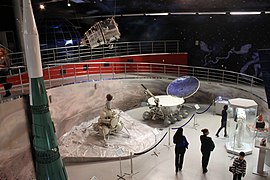Luna 10
 Luna 10 mockup, Le Bourget (France) | |
| Mission type | Lunar orbiter |
|---|---|
| Operator | GSMZ Lavochkin |
| COSPAR ID | 1966-027A |
| SATCAT no. | 02126 |
| Mission duration | 60 days |
| Spacecraft properties | |
| Spacecraft type | E-6S |
| Manufacturer | GSMZ Lavochkin |
| Launch mass | 1,583.7 kg[1] |
| Dry mass | 540 kg |
| Start of mission | |
| Launch date | 31 March 1966, 10:46:59 UTC[1] |
| Rocket | Molniya-M 8K78M |
| Launch site | Baikonur, Site 31/6 |
| End of mission | |
| Last contact | 30 May 1966 |
| Orbital parameters | |
| Reference system | Selenocentric |
| Periselene altitude | 2088 km |
| Aposelene altitude | 2738 km |
| Inclination | 71.9° |
| Period | 178.05 minutes |
| Lunar orbiter | |
| Orbital insertion | 3 April 1966, 18:44 GMT |
| Instruments | |
| Magnetometer Gamma-ray spectrometer Five gas-discharge counters Two ion traps/charged particle trap Piezoelectric micrometeorite detector Infrared detector Low-energy x-ray photon counters | |
Luna 10 (or Lunik 10) was a 1966 Soviet lunar robotic spacecraft mission in the Luna program. It was the first artificial satellite of the Moon.[2]
Luna 10 conducted extensive research in lunar orbit, gathering important data on the strength of the Moon's magnetic field,[3] its radiation belts, and the nature of lunar rocks (which were found to be comparable to terrestrial basalt rocks),[4] cosmic radiation, and micrometeoroid density. Perhaps its most important finding was the first evidence of mass concentrations (called "mascons") — areas of high density below the mare basins that distort lunar orbital trajectories.[5][6] Their discovery has usually been credited to the American Lunar Orbiter series.
The spacecraft
Part of the E-6S series, Luna 10 was battery powered and had an on-orbit dry mass of 540 kg. Scientific instruments included a gamma-ray spectrometer for energies between 0.3–3 MeV (50–500 pJ),[4] a triaxial magnetometer, a meteorite detector, instruments for solar-plasma studies, and devices for measuring infrared emissions from the Moon and radiation conditions of the lunar environment. Gravitational studies were also conducted.
-
 Replica of Luna 10 space probe, K. E. Tsiolkovsky Museum of the History of Cosmonautics
Replica of Luna 10 space probe, K. E. Tsiolkovsky Museum of the History of Cosmonautics -
 Luna 10 model (suspended), Memorial Museum of Cosmonautics
Luna 10 model (suspended), Memorial Museum of Cosmonautics
The flight
Luna 10 launched towards the Moon on 31 March 1966 at 10:48 GMT.[7]
After a midcourse correction on 1 April, the spacecraft entered lunar orbit on 3 April 1966 and completed its first orbit 3 hours later (on 4 April Moscow time).[8] A 245-kilogram[7] instrument compartment separated from the main bus, which was in a 350 x 1,000-kilometre orbit inclined at 71.9° to the lunar equator.
Luna 10 operated for 460 lunar orbits and performed 219 active data transmissions before radio signals were discontinued on 30 May 1966.[9]
The Internationale
The spacecraft carried a set of solid-state oscillators that had been programmed to reproduce the notes of "The Internationale", so that it could be broadcast live to the 23rd Congress of the Communist Party of the Soviet Union.[10] During a rehearsal on the night of 3 April, the playback went well, but the following morning, controllers discovered a missing note and played the previous night's tape to the assembled gathering at the Congress — claiming it was a live broadcast from the Moon.[11]
References
- ^ a b Siddiqi, Asif (2018). Beyond Earth: A Chronicle of Deep Space Exploration, 1958–2016 (PDF) (second ed.). NASA History Program Office. ISBN 9781626830431.
- ^ Siddiqi, Asif A. (2018). Beyond Earth: A Chronicle of Deep Space Exploration, 1958–2016 (PDF). The NASA history series (second ed.). Washington, D.C.: NASA History Program Office. p. 1. ISBN 9781626830424. LCCN 2017059404. SP2018-4041.
- ^ Measurements of the Magnetic Field in the Vicinity of the Moon on the AMS LUNA-10 (PDF) (Report). Archived (PDF) from the original on 19 November 2021. Retrieved 13 November 2022.
- ^ a b "Measurements of Gamma Radiation of the Lunar Surface on the Space Station LUNA-10" (PDF). Archived from the original (PDF) on 19 November 2021. Retrieved 19 November 2021.
- ^ Harvey, Brian (17 August 2007). Soviet and Russian Lunar Exploration. Springer Science & Business Media. ISBN 9780387739762 – via Google Books.
- ^ Determination of the Gravitational Field of the Moon by the Motion of the AMs LUNA-10 (PDF) (Report). Archived (PDF) from the original on 19 November 2021. Retrieved 13 November 2022.
- ^ a b Kopal, Zdeněk (23 September 1971). A New Photographic Atlas of the Moon. Taplinger. ISBN 9780800855154 – via Google Books.
- ^ "Pittsburgh Post-Gazette". Pittsburgh Post-Gazette – via Google Books.
- ^ "Soviet-bloc Research in Geophysics, Astronomy, and Space". U.S. Joint Publications Research Service; may be ordered from National Technical Information Service, Springfield, Va. 19 November 1968 – via Google Books.
- ^ "Soviet Says Satellite Orbits Moon". Sarasota Herald-Tribune. Retrieved 13 November 2022 – via Google Books.
- ^ Siddiqi, Asif A. (2002). "Deep Space Chronicle: A Chronology of Deep Space and Planetary Probes 1958–2000" (PDF). NASA History Office. Monographs in Aerospace History, No. 24. p. 53. Archived (PDF) from the original on 5 July 2003.
External links
- Zarya - Luna 10 chronology
- v
- t
- e












